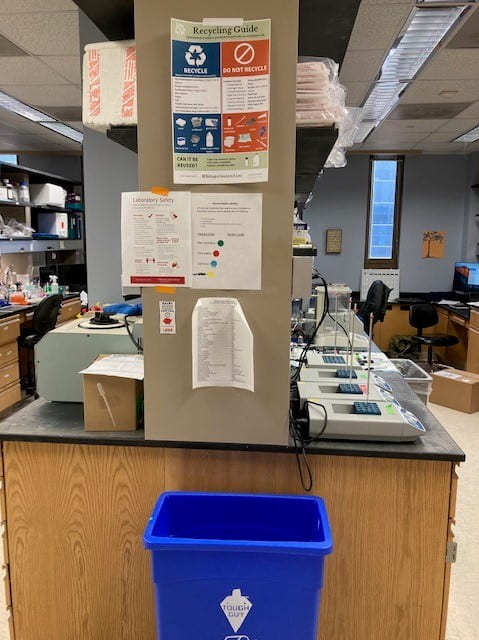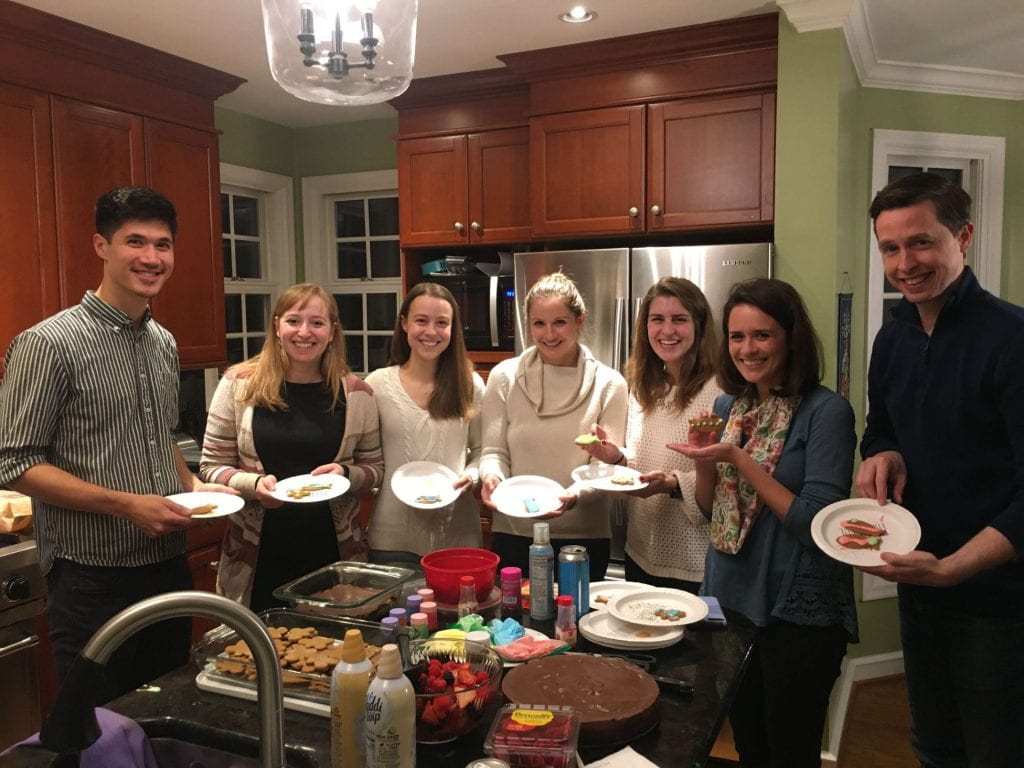The lab of Dr. Charles Kaufman at the Washington University School of Medicine is a tight-knit group of researchers studying the mechanisms that control the onset of melanoma cancer and identifying cancerous cells as early as possible. They are also deeply committed to sustainability on campus and in their personal lives.
As regular participants in Sustainability programming at WUSM, they were one of the earliest labs to join the newly launched Green Labs Program in early 2020. They are particularly interested in reducing energy use, product packaging, and waste from their research activities. They also discuss ways to be more sustainable in their personal lives too, like reducing meat and dairy consumption, avoiding fast fashion, and more.
Energy Conservation
About 60% of energy use in laboratories is at the plug-level, which means that individuals have the ability to dramatically reduce their energy use simply by unplugging equipment that is not actively in use. Lab equipment and any other electrical item (fans, lamps, phone chargers) all draw electricity from outlets when they are plugged in, whether they are in use or not. This phenomenon known as phantom energy draw exists in almost every building you inhabit – at work and at home. By simply unplugging items that aren’t currently in use, you can significantly reduce the energy demand in your space. The Kaufman lab members save energy by taking a few extra seconds to unplug their benchtop equipment, which they labelled with “Unplug” stickers, when they aren’t in use. This is especially important overnight, on weekends, and on extended holiday breaks.
Another quick way to reduce energy-use and improve the safety of your lab is to shut the sash on fume hoods when not in use, which has become a habit for the researchers in the Kaufman Lab. Shutting the sash can significantly reduce the energy demand in your space by reducing the air flow to and from the fume hood and it sometimes powers down internal lights – that’s why you may see “Shut the Sash” stickers on fume hoods across campus (request signage for your lab here).
Packaging and Waste Reduction
One of the biggest struggles faced by WashU researchers is product packaging and receiving an excess amount of polystyrene (Styrofoam) coolers. After attending Recycling Genius trainings, the Kaufman lab researchers started to analyze the products they use on a daily basis and ways they can swap to reusable products (like glass vials that can be cleaned and sterilized instead of a single-use plastic product) or opting for recyclable materials instead of items that must go into the landfill waste. These small steps really do add up. With over 1,000 labs at WashU, if every researcher made these conscious decisions to reduce their waste, the results would be astonishing.

“Through the amazing programming provided by the Office of Sustainability, I have become more confident in knowing what is a sustainable practice and what it is not. For example, I recently noticed a lot of paper towels in the recycling bin in our break room and am planning to post a “what to recycle/what not to recycle” visual aid above the waste bin and the recycling bin.”
– Paula Godoy, Graduate Student in the Kaufman Lab
The researchers also try to avoid unnecessary packaging waste by buying in bulk when possible and actively contacting companies that use wasteful packaging and shipping materials. Many sustainable solutions are better solved upstream – at the manufacturer/distributor level – and by contacting companies and making our voices heard, we can create real lasting change.
“In my lab, led by the efforts of my students who really opened my eyes to this issue, we have increasingly focused on reducing waste and energy. We have implemented small but impactful changes, such as increasing our thermocycler holds to 12C up from 4C, bringing our own utensils and reusable bowls for lab meeting snacks, and considering how to be the most efficient with every product we purchase. We are all very dedicated to decreasing our carbon footprint.”
Dr. Charles Kaufman
Reducing energy demand and landfill waste from research activities are two of the most straightforward and most impactful things researchers can do to reduce the environmental footprint of their research. Putting sustainability into practice can sometimes include large sweeping changes and feel out of reach; but by changing individual behaviors, and supporting those around you to make changes, true change happens. Sometimes, these types of meaningful changes can slide under the radar or go unnoticed. By highlighting the Kaufman Lab, the Ley Lab, and other WashU Green Labs, we are celebrating these sometimes quiet actions and making them part of the spotlight. The actions of these researchers, combined with other labs across campus, are reducing our collective impact on our planet.
Resources
If you are interested in seeing your lab featured here, contact us at greenlabs@wustl.edu
Join the Green Labs Program and start making changes by visiting greenlabs.wustl.edu
